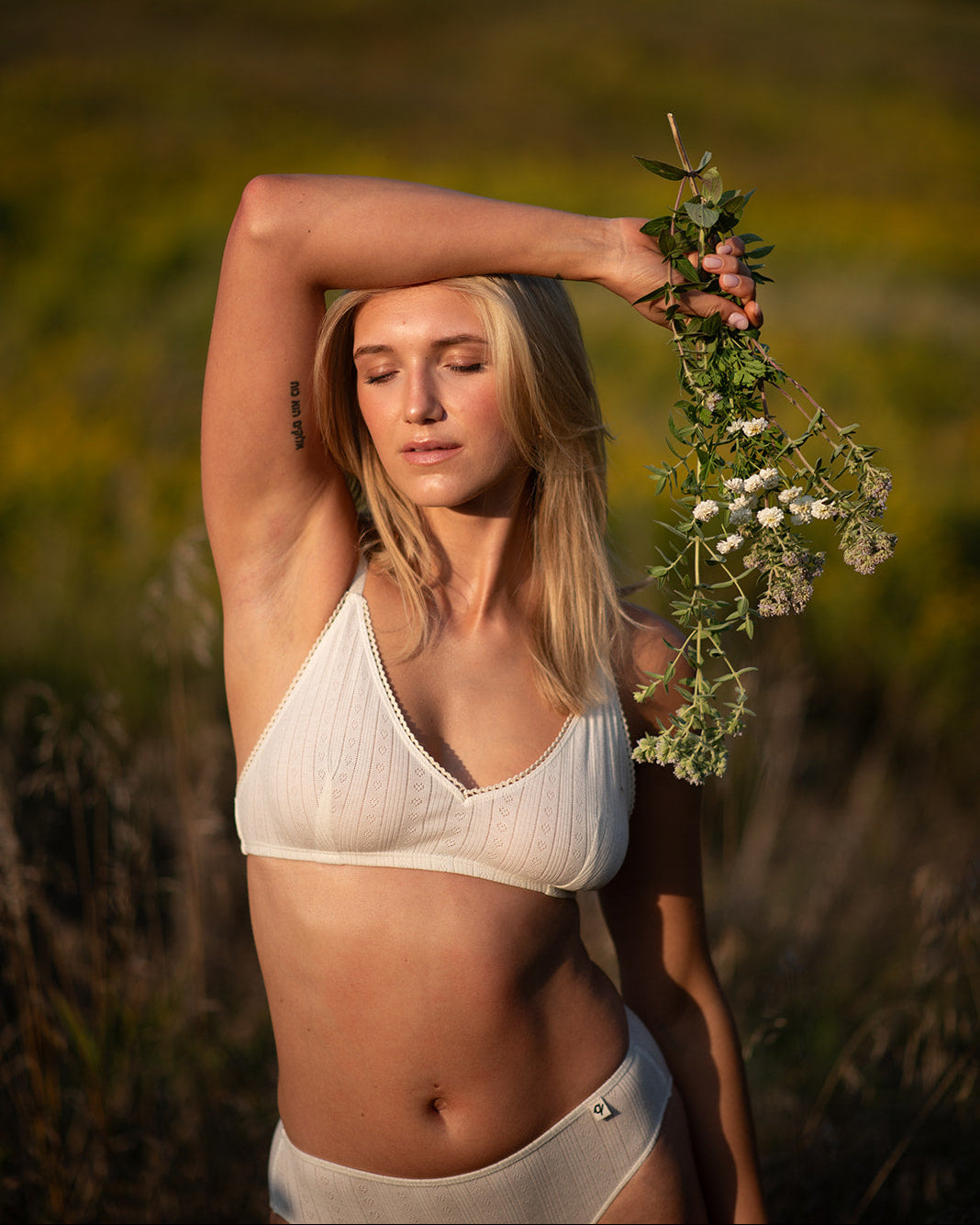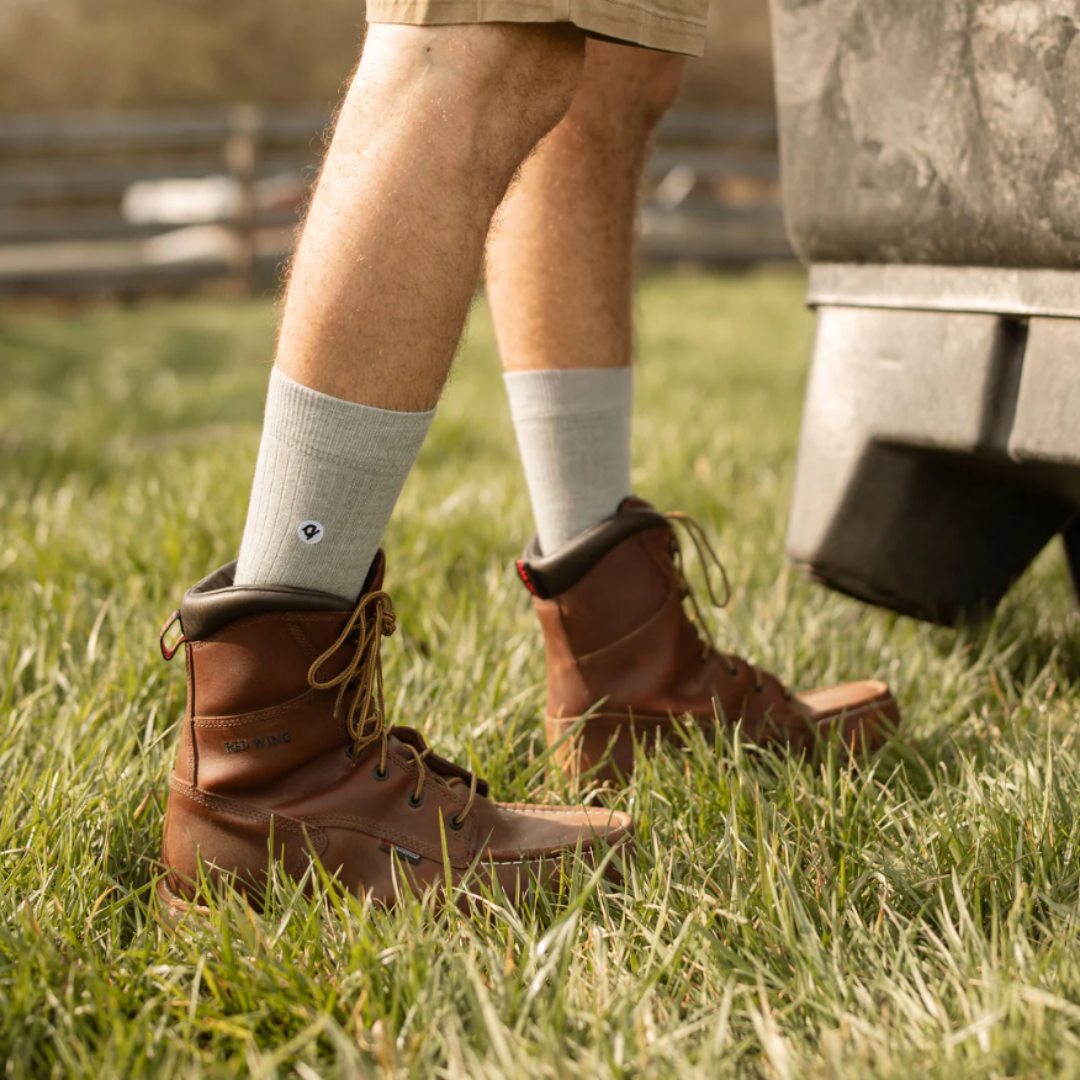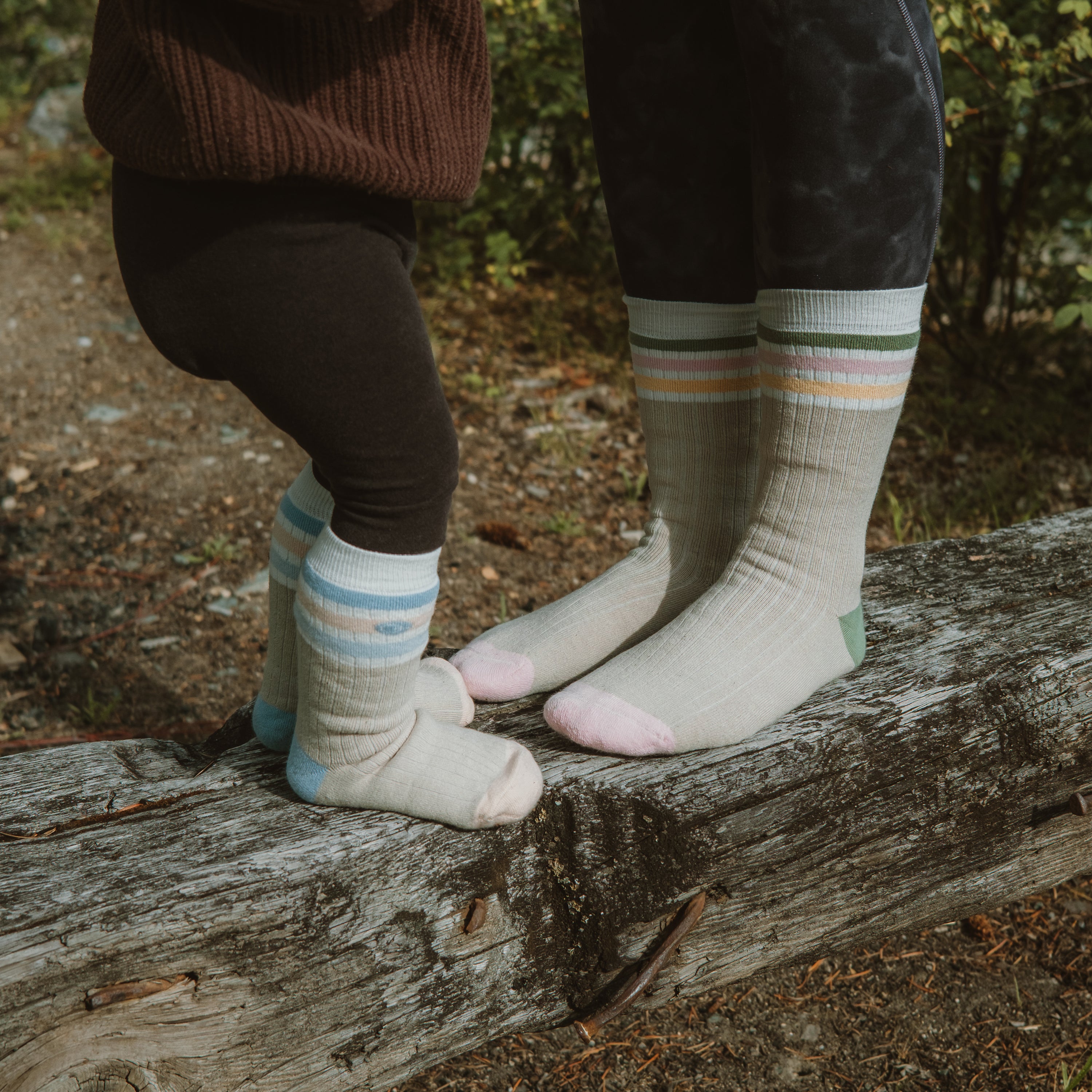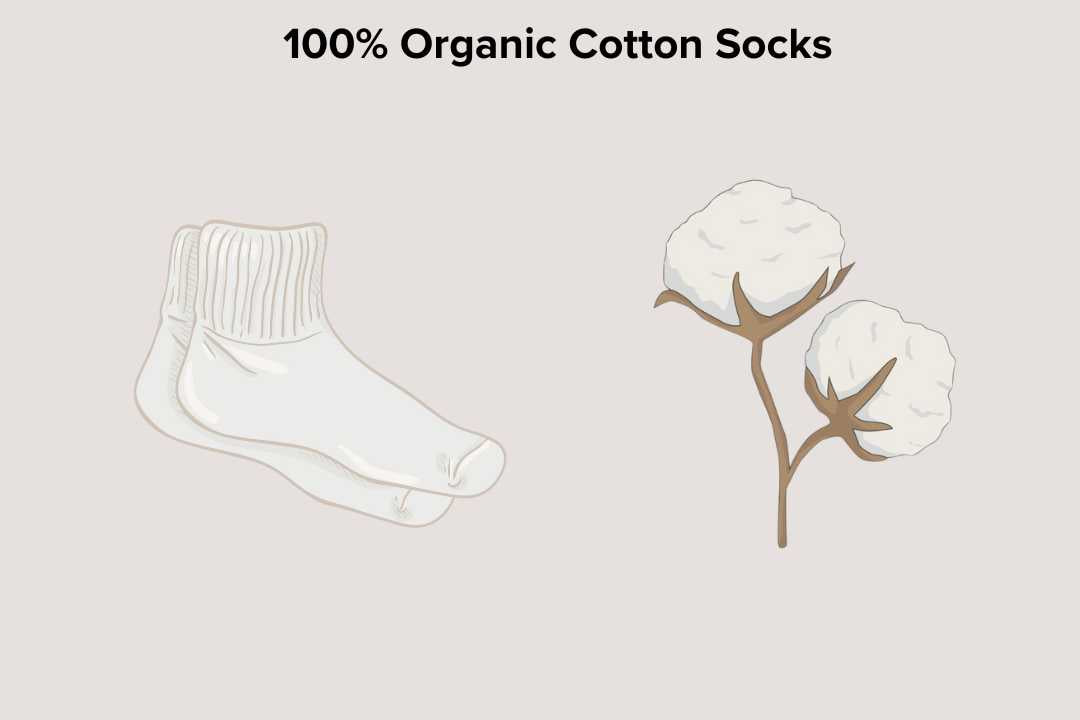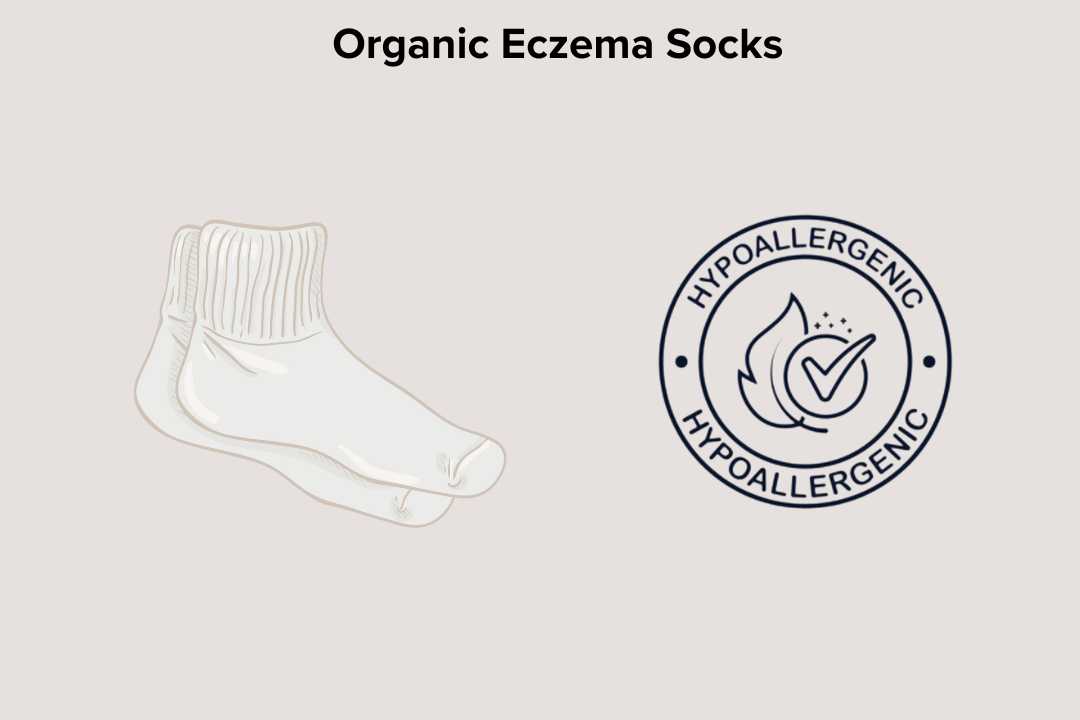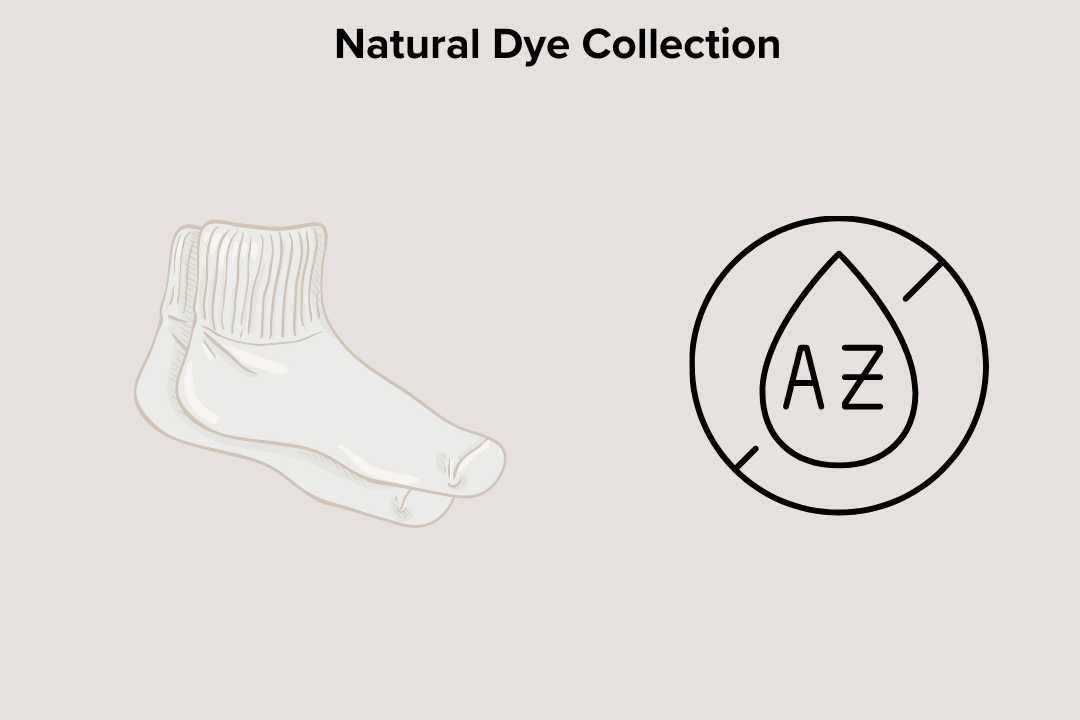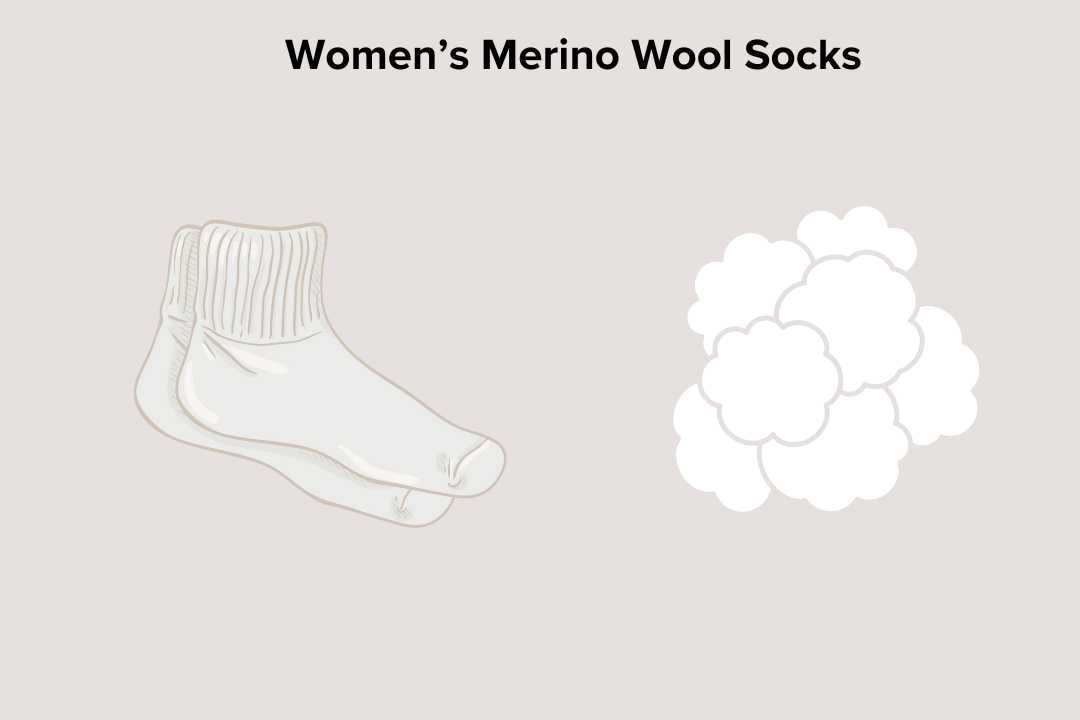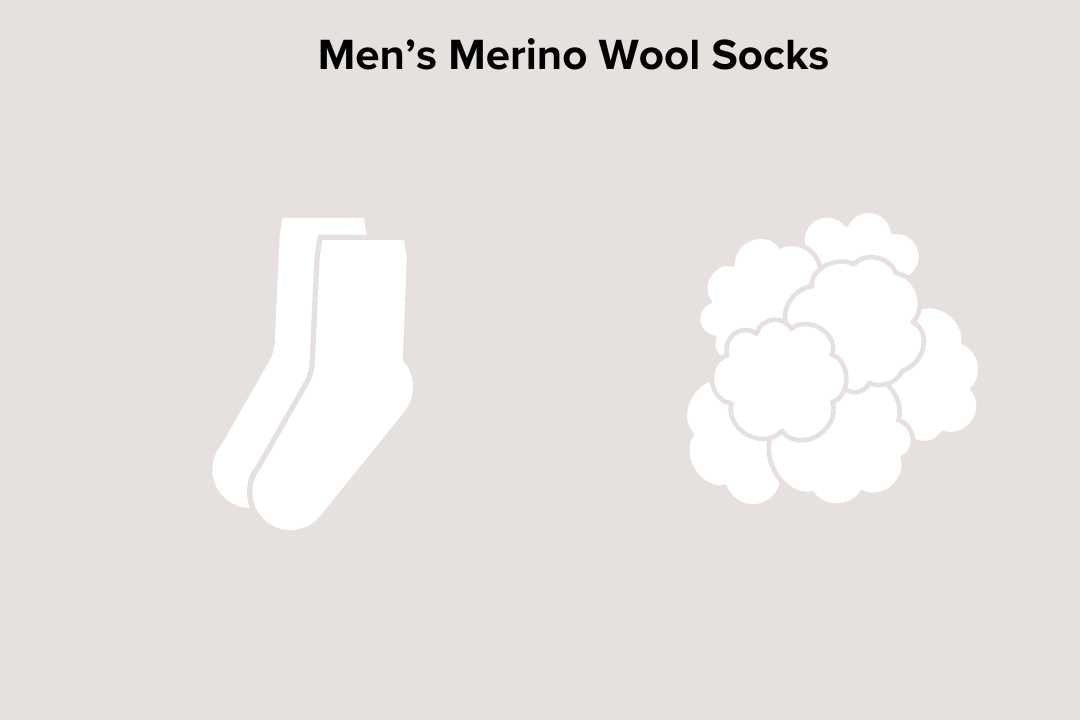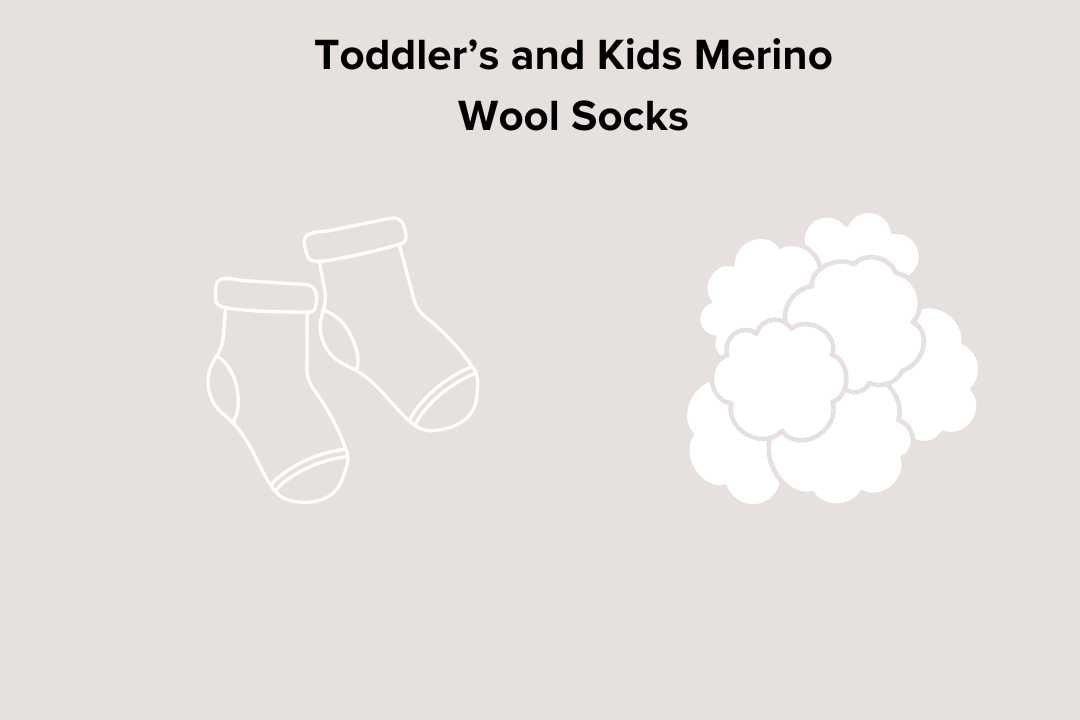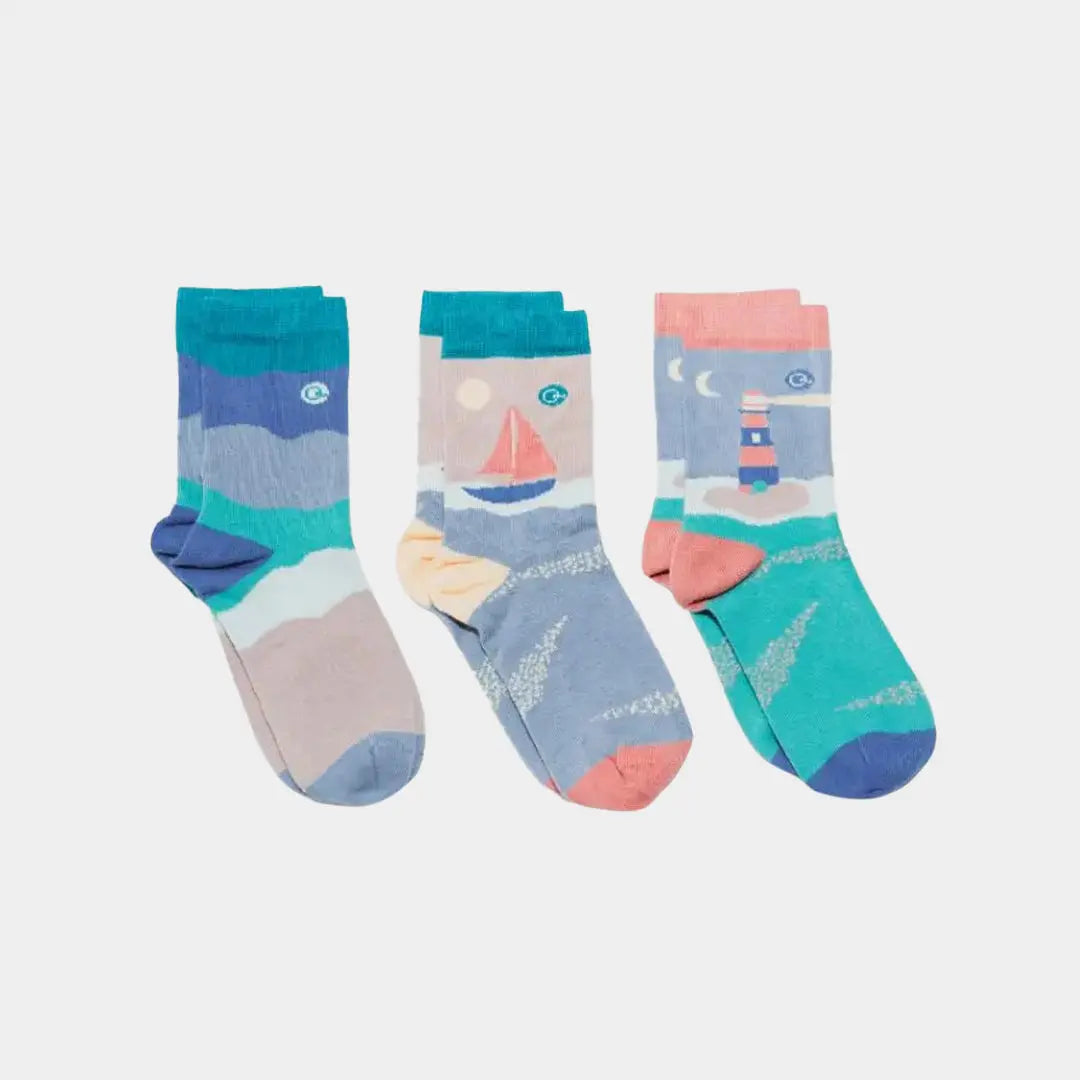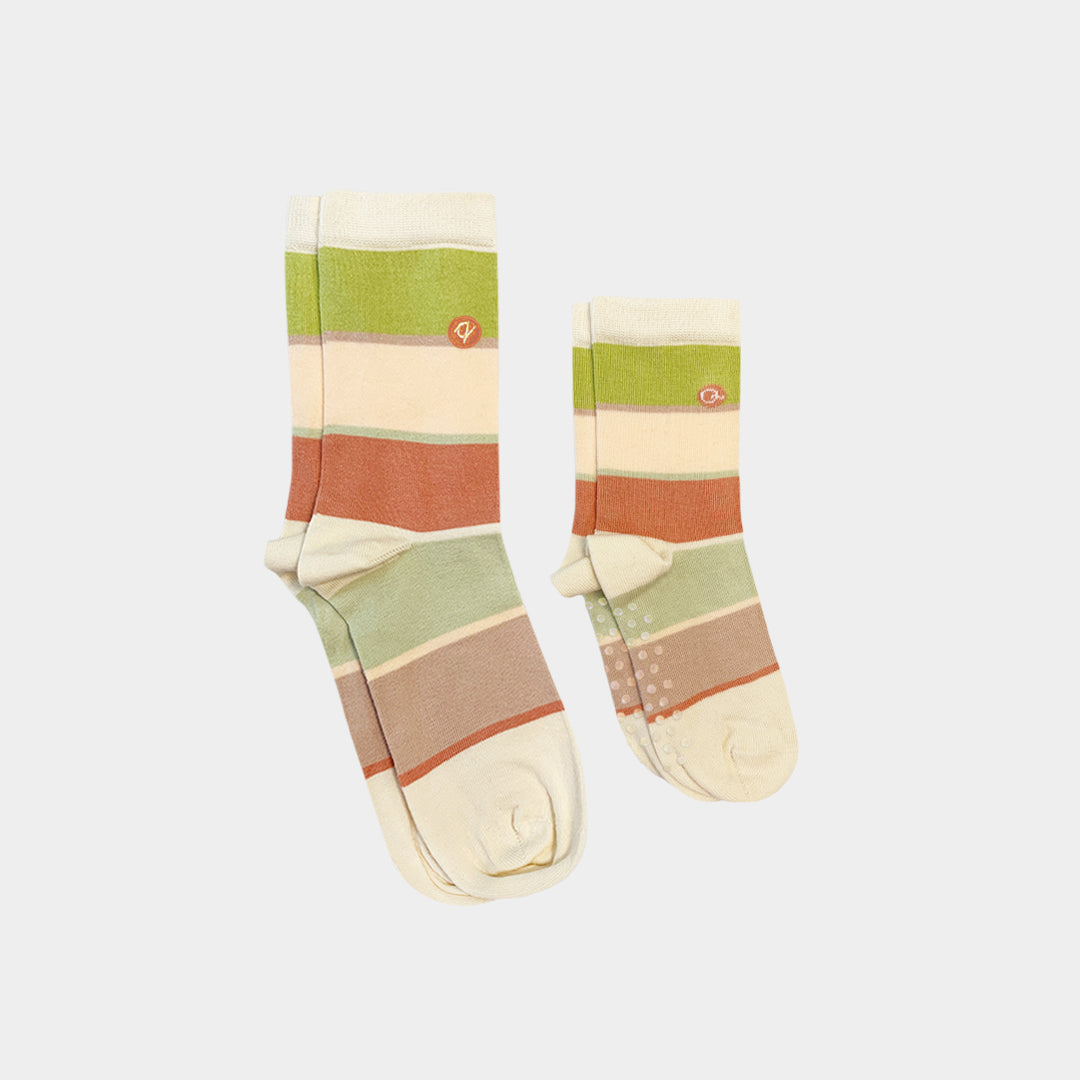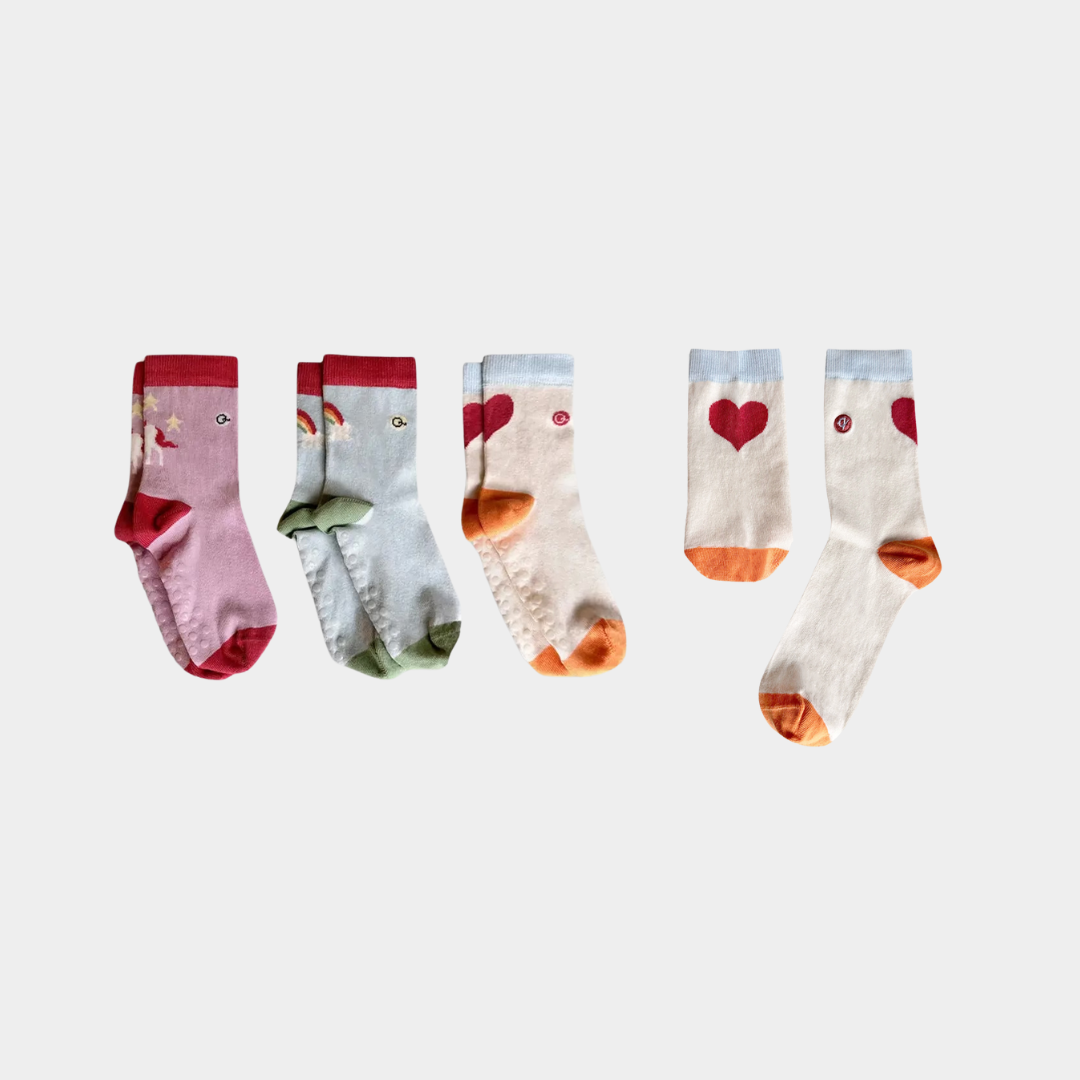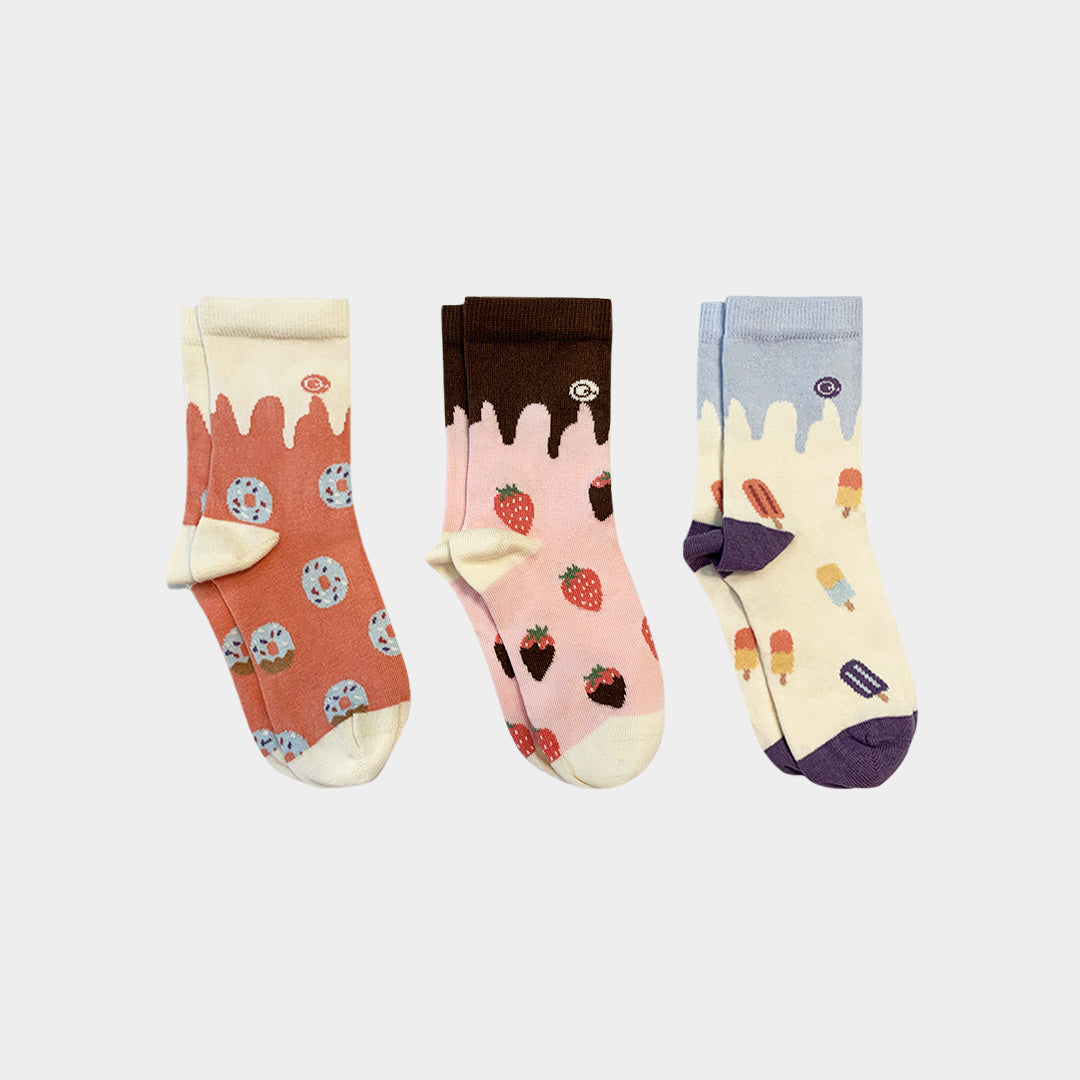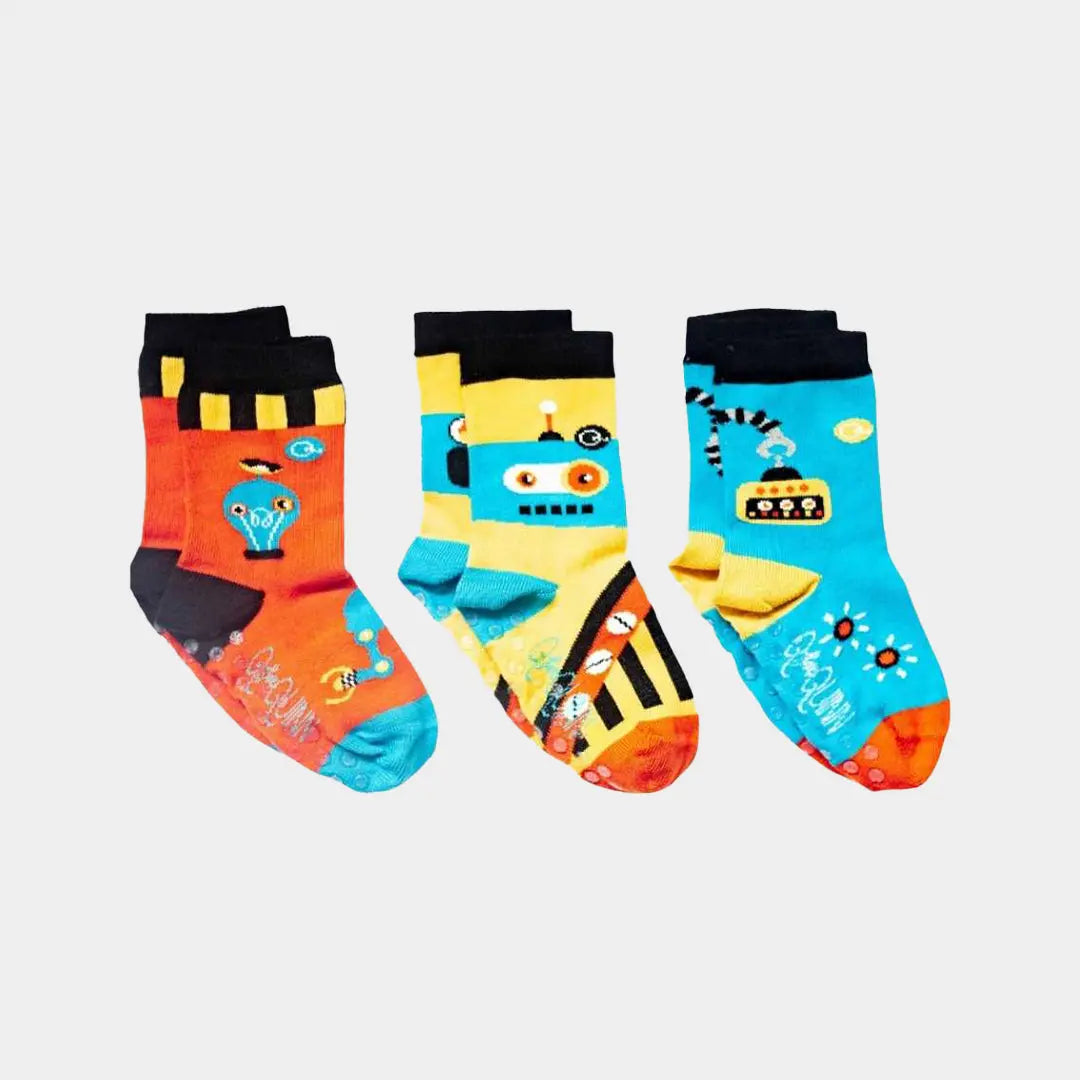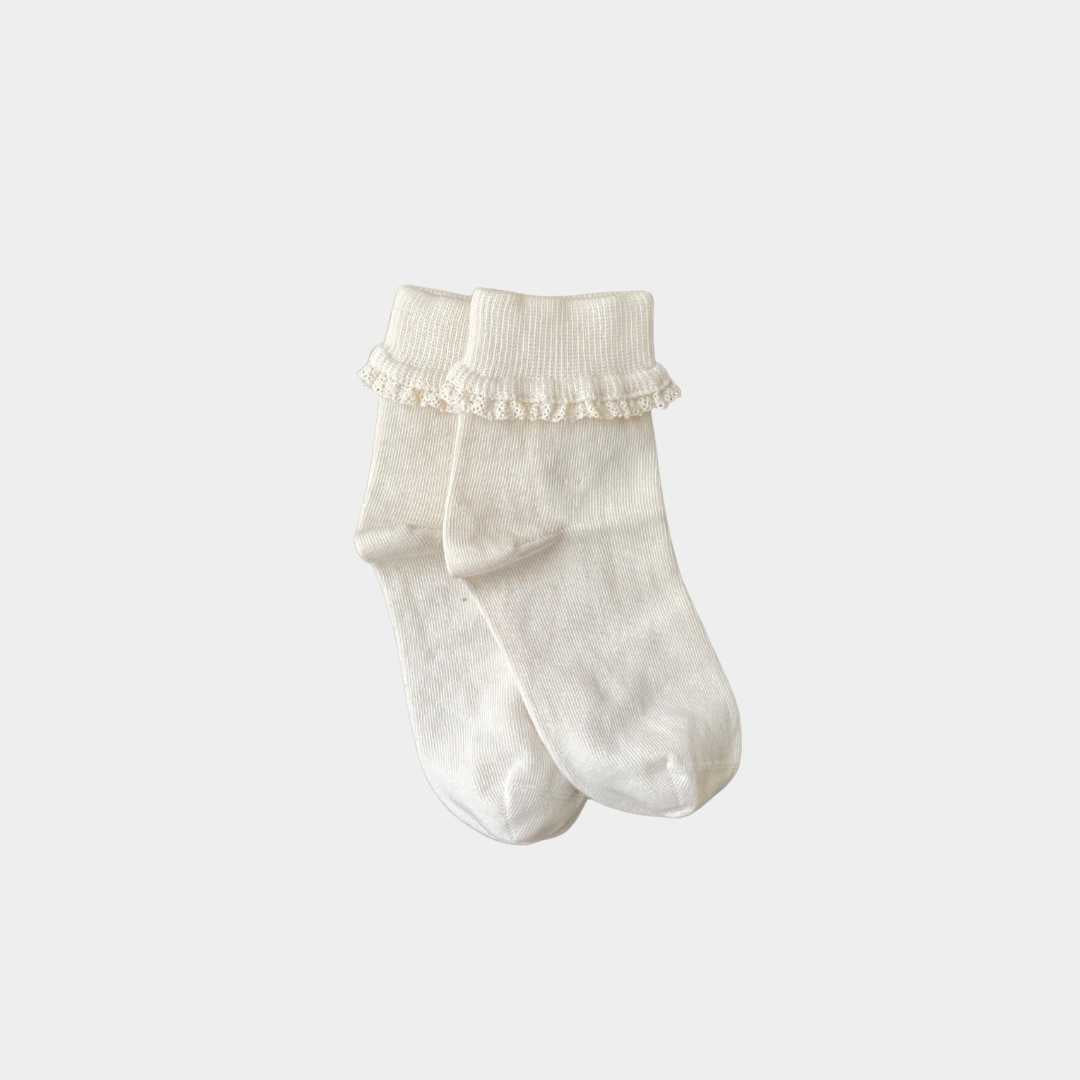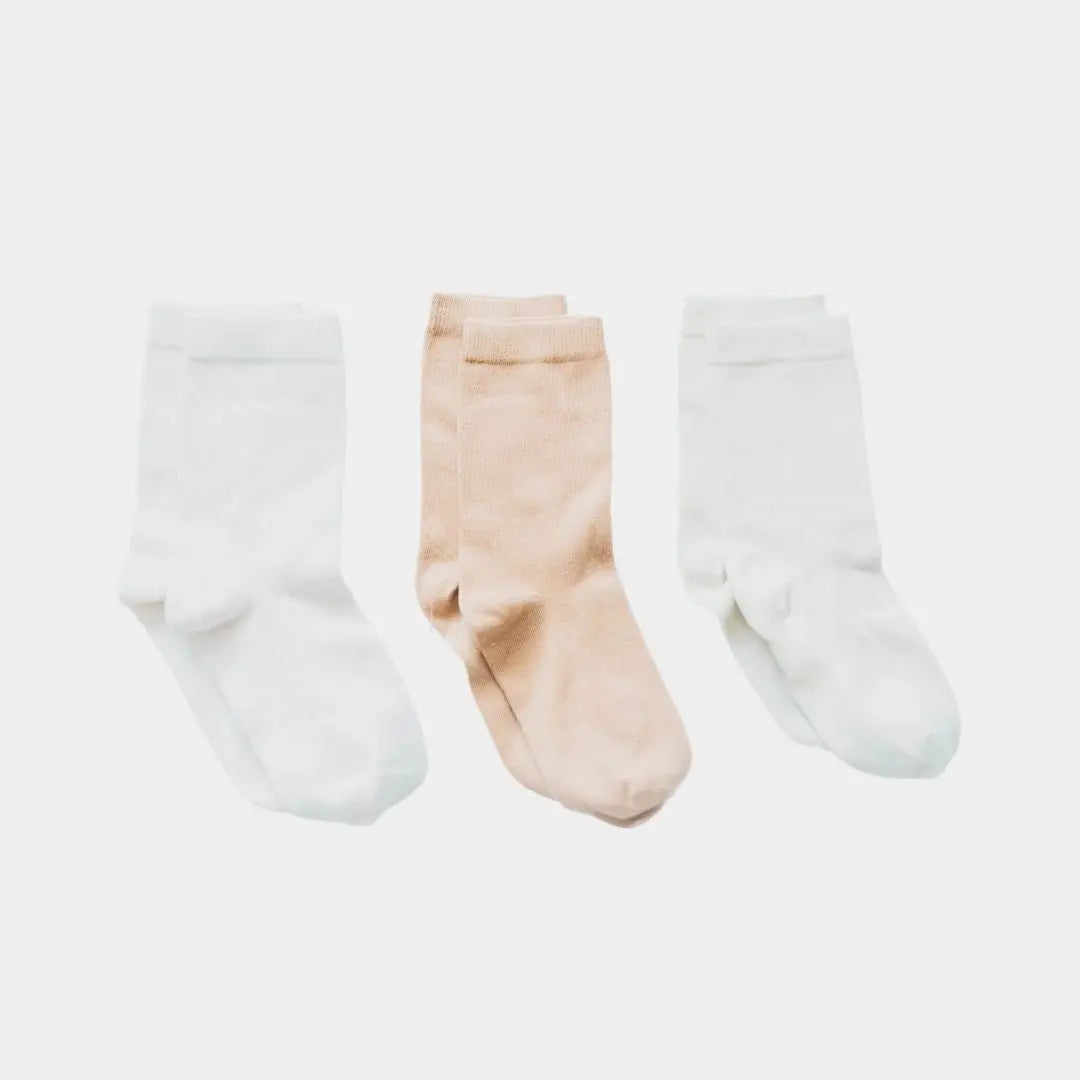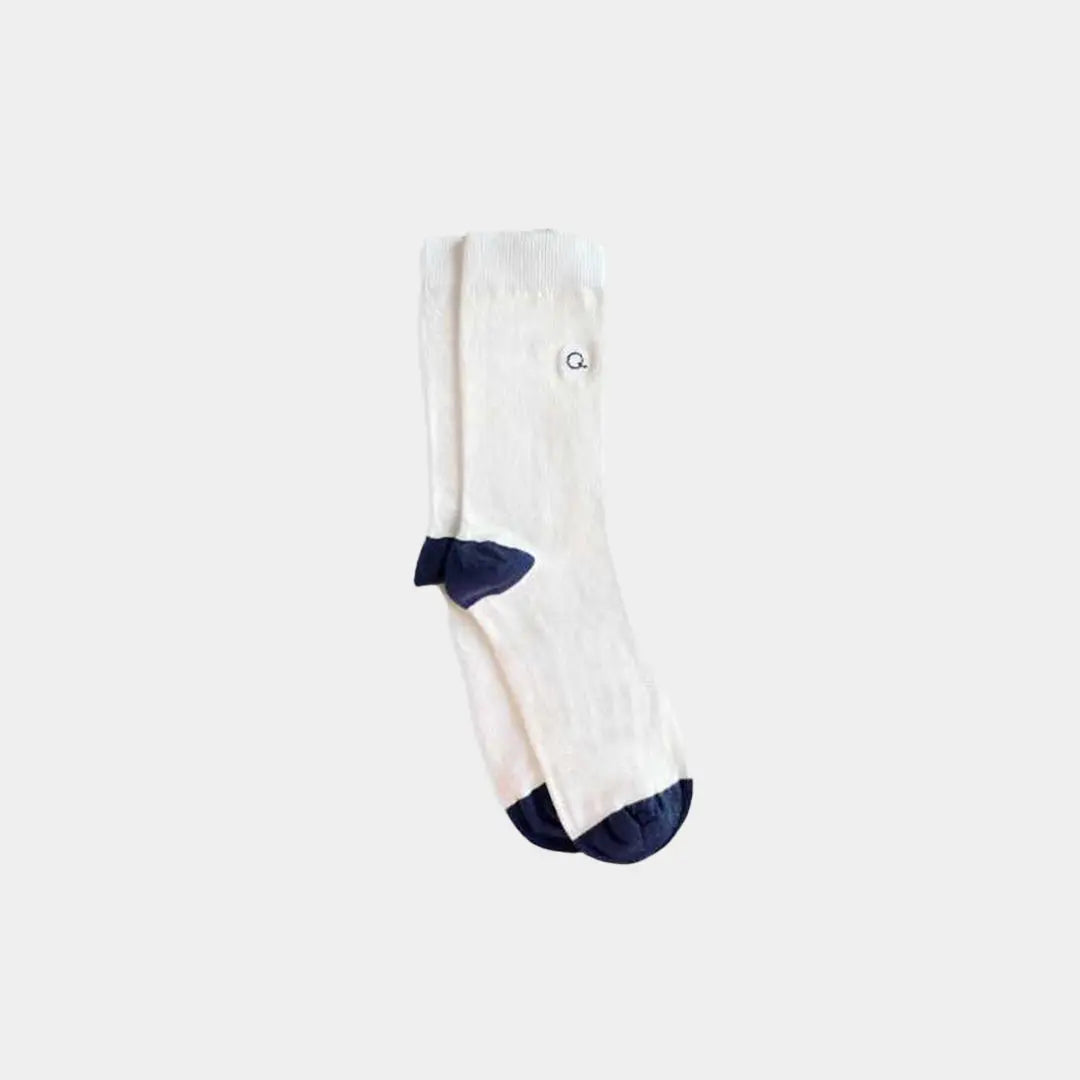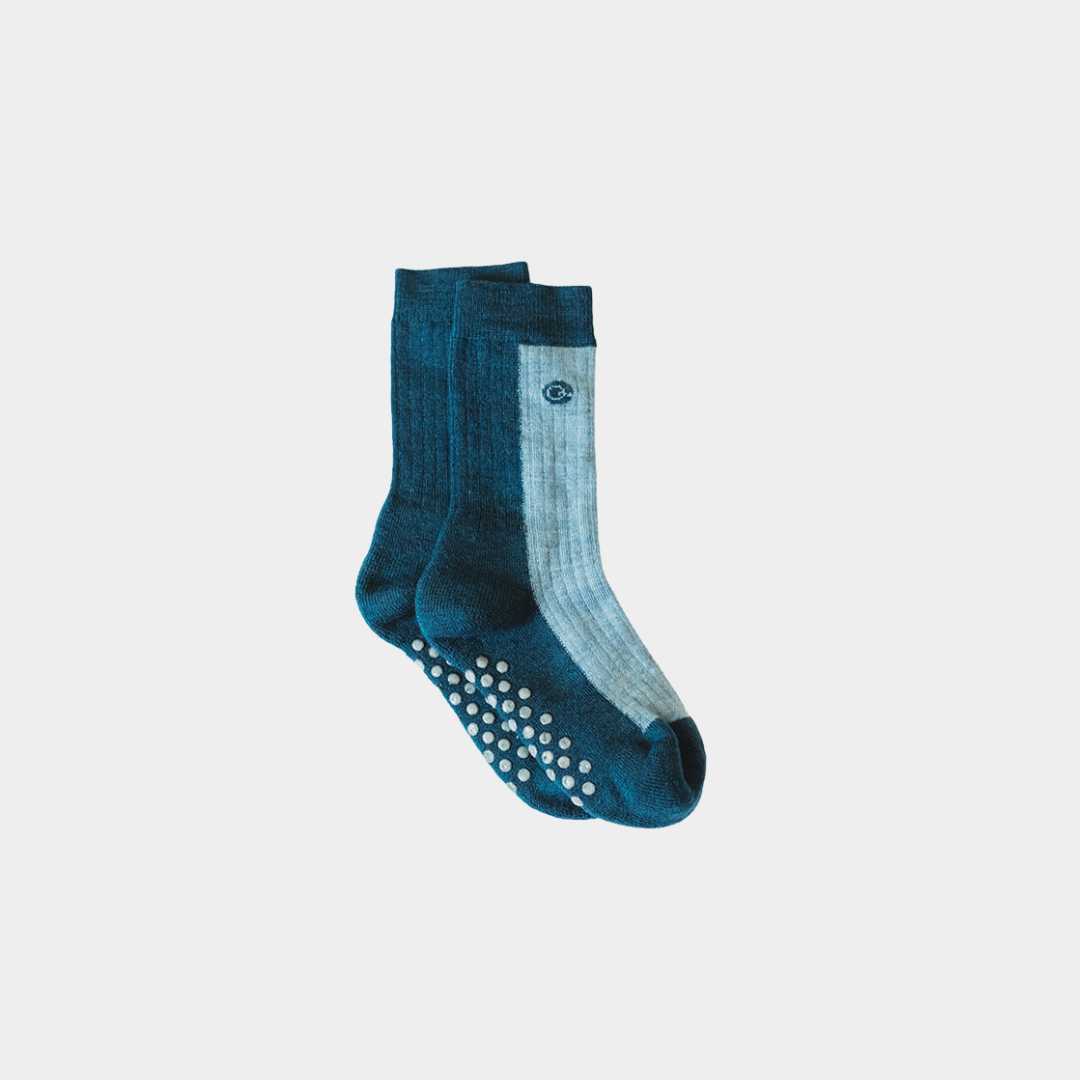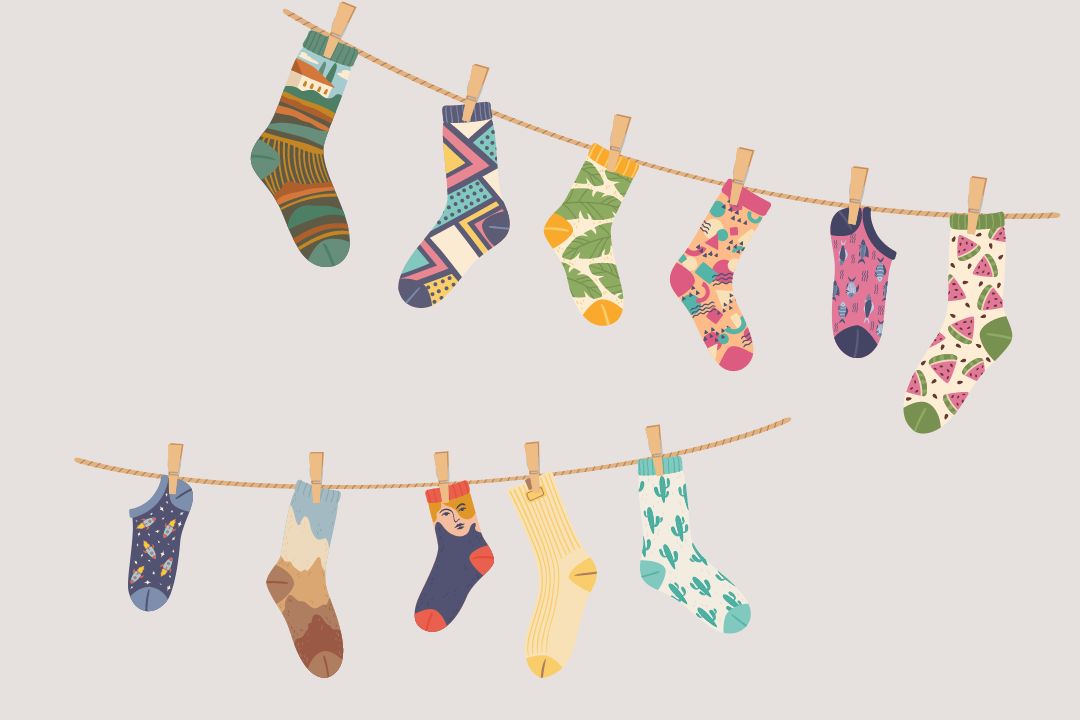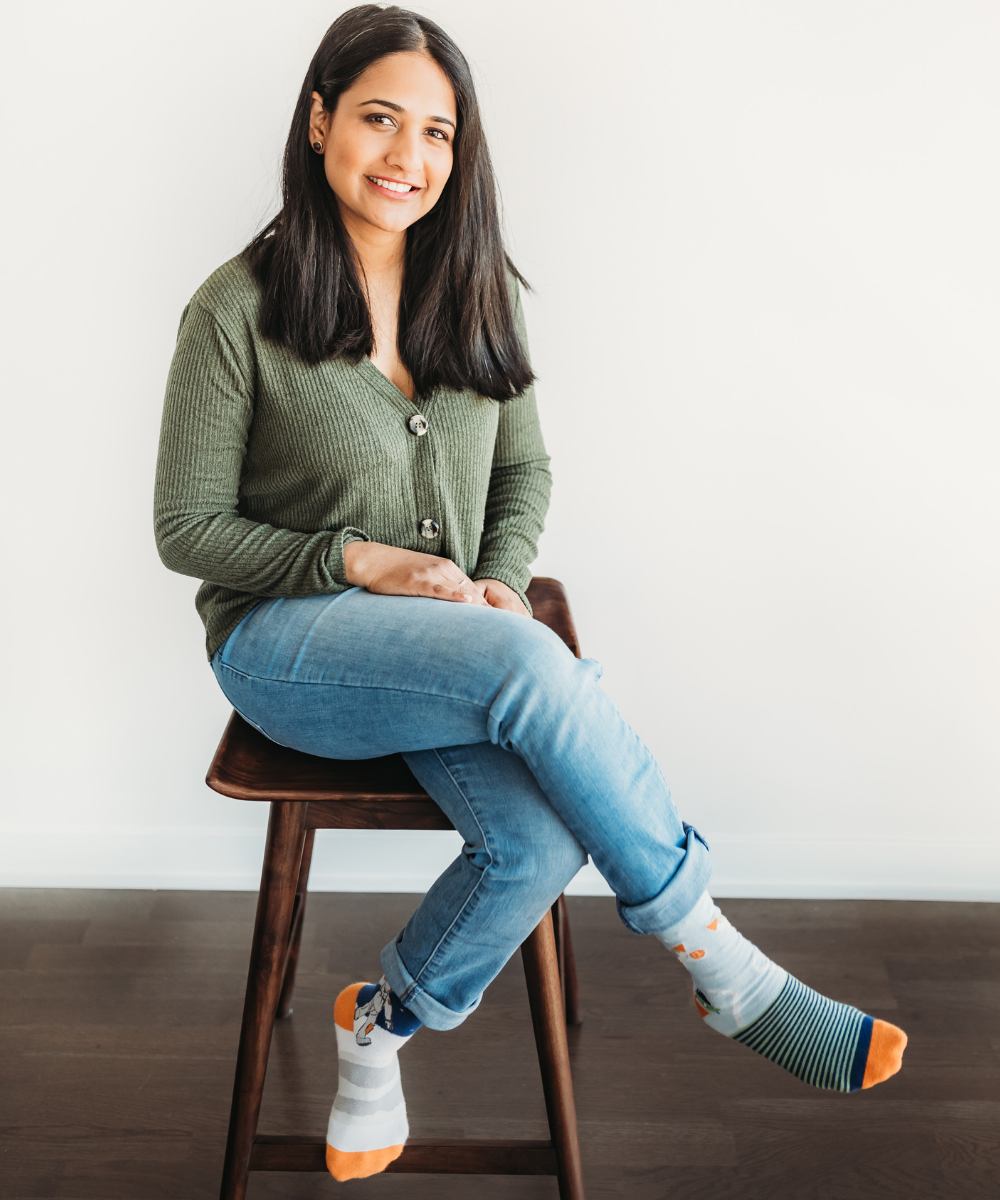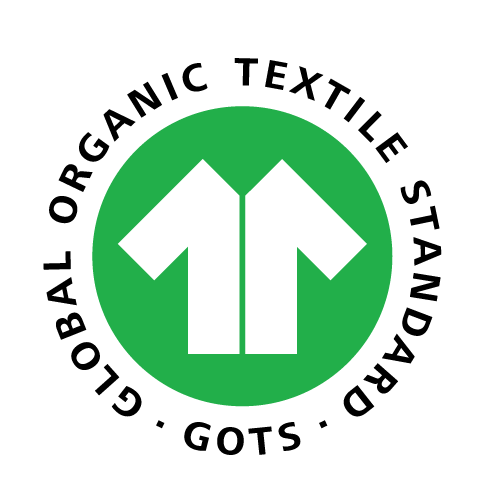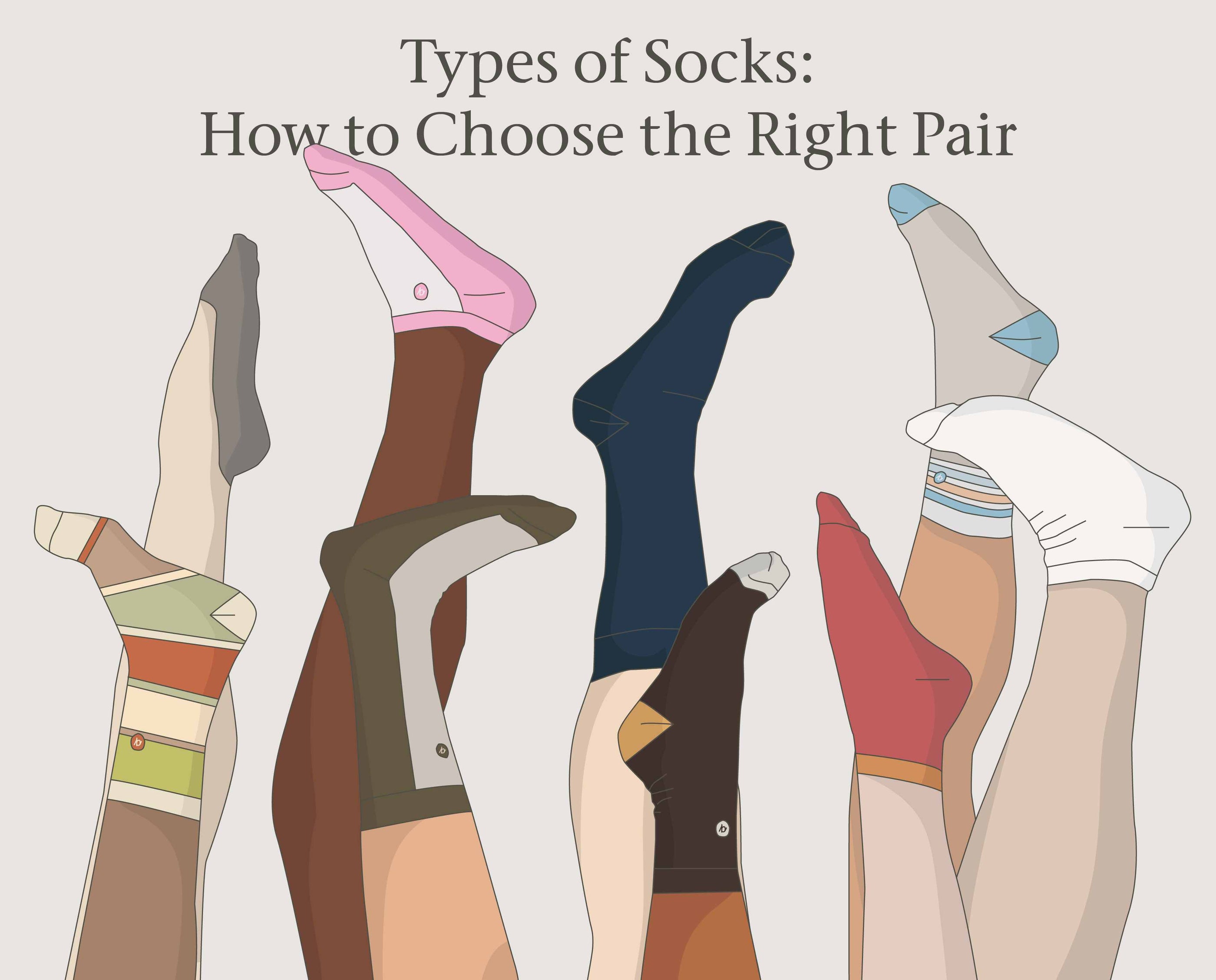
Styles and Types of Socks: How to Choose the Right Pair
Choosing the right socks isn't just about picking the first pair you see. The right socks can make a big difference in how comfortable you feel, look stylish, and even perform in sports or other activities.
From the fabric they’re made of to their length and weight, every aspect of a sock can affect your overall experience. Whether you're dressing up for a formal event, heading to the gym, or just lounging at home, there's a perfect pair of socks. Let's explore the many types of socks and how to choose the ideal pair for any occasion.
Factors to Consider When Choosing Socks
Choosing the right socks involves several considerations. Here are the key factors to keep in mind:
- Materials: Always prioritize comfort. The best socks feel like a second skin, providing a comfortable barrier between your feet and shoes.
- Length: Match the sock length to your outfit and activity. No-show socks are ideal for low-cut shoes, ankle socks for casual wear or sports, crew socks for everyday use, and knee-high socks for added warmth or a bold fashion statement.
- Weight: Select lightweight socks for warm weather or layering, medium-weight socks for moderate temperatures and everyday use, and heavyweight socks for cold weather or activities requiring extra cushioning.
- Occasion: Consider the occasion when choosing socks. For formal events, choose sleek, neutral-colored dress socks. Casual outings can feature colorful or patterned socks. Sports activities require performance socks, while special occasions allow for fun and unique designs.
- Sock Pairing: Coordinate your socks with your outfit and shoes for a cohesive look. Pay attention to color and pattern to enhance your overall style.
- Style and Design: Express your personality with bold patterns and bright colors, or choose solid, neutral tones for a timeless look. Select designs that reflect your taste.
- Feet Shape: Foot shape mainly impacts shoe selection, but a good sock fit can enhance comfort. Choose socks that conform well to your feet to prevent blisters and discomfort. Experiment with different styles and sizes to find the best fit for your unique foot shape.
- Gender and Age: Socks are tailored to fit different genders and age groups, addressing specific needs. Men's socks are larger and come in neutral colors for wider feet. Women's socks have a snugger fit with diverse designs for narrower feet. Children's socks are smaller with playful patterns, often including reinforced toes and non-slip grips for safety.
Understanding Sock Materials
The material of your socks is key to their comfort, hygiene, and durability. The fabric you choose affects how you feel all day, whether working, exercising, or out for the evening. Knowing each type's unique properties and benefits is important to finding the best material for socks. Here’s a quick overview of common sock materials:
1. Cotton: breathable and soft, cotton is one of the best materials for everyday use. It's comfortable and gentle on the skin.
Choosing the right sock material can significantly benefit your health. Cotton socks, for instance, prevent skin irritation and allergies while providing good ventilation to maintain foot hygiene. For conditions like eczema or diabetes, natural, hypoallergenic materials can prevent complications and ensure comfort.
2. Wool: Warm and moisture-wicking, wool is ideal for colder climates. It keeps your feet warm and dry.
3. Merino Wool: A finer, softer wool that offers excellent temperature regulation. It's great for both warm and cold weather.
4. Synthetic Socks (e.g., polyester, nylon): While durable and quick-drying, synthetic materials feel less breathable and may not be as comfortable against the skin.
5. Bamboo Socks: Although soft and eco-friendly, bamboo socks may lack the durability needed for long-term wear.
6. Silk: Smooth and lightweight, silk socks work for dressier occasions but lack the durability for regular use.
Types of Socks by Length
Socks come in different sock lengths, each serving various functions and fashion purposes. Here’s a look at the types of socks by length and what they pair best with:
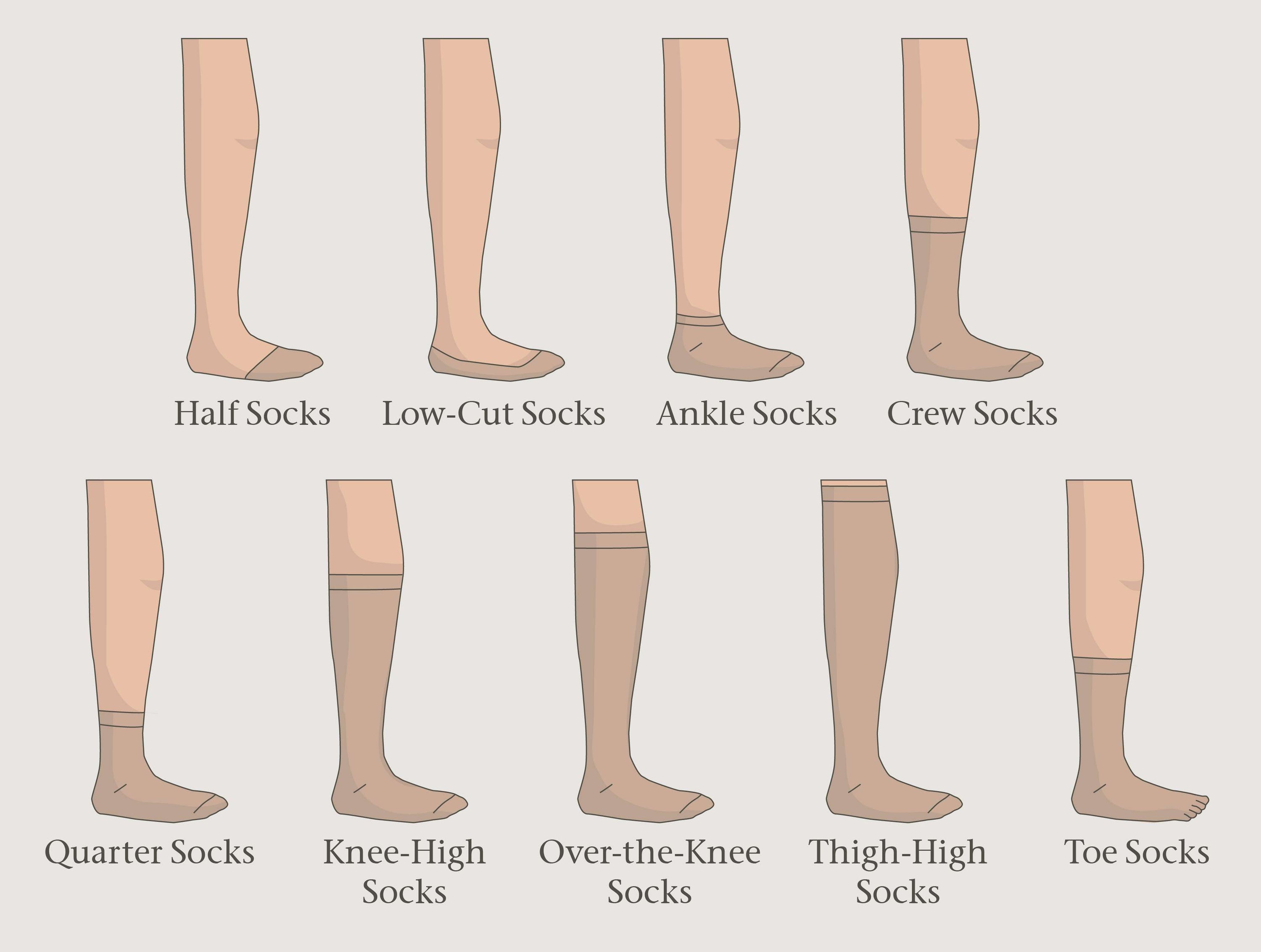
Half Socks
Half socks, also known as toe or footie socks, cover just the toes and the ball of the foot. These minimalistic socks are perfect for cushion and friction protection without adding bulk. They are often used with ballet flats or other low-profile shoes where minimal coverage is desired.
Low-Cut Socks (No-Show Socks)
Low-cut or no-show socks cover the foot up to just below the ankle. These socks wrap around the entire foot, offering protection from blisters and sweat while staying hidden beneath the shoe line. They are ideal for those who prefer a sleek look without visible sock lines.
Ankle Socks
Ankle socks extend slightly above the ankle bone, offering more coverage than no-show socks. They protect the entire foot and the lower part of the ankle. Ankle socks are popular for everyday wear, sports, and activities where more coverage and support are needed.
Crew Socks
Crew socks are one of the most versatile lengths, covering the foot and extending up to the mid-calf or slightly higher. They provide ample coverage and warmth, making them suitable for various activities and outfits. Cotton crew socks are often worn for everyday casual, sports, and business casual settings. When considering crew socks vs. ankle socks, crew socks offer more coverage and are often preferred for cooler weather or when extra warmth and support are needed.
Quarter Socks (Mid-Calf Socks)
Quarter or mid-calf socks cover the foot and extend to the lower calf. These socks provide coverage and protection up to the mid-calf area, making them suitable for various sports and casual sports. They offer a balance between ankle socks and crew socks. Comparing quarter socks vs ankle socks, it’s clear that quarter socks provide more coverage, while ankle socks sit just below the ankle bone for a lighter, more minimal feel.
Knee-High Socks
Knee-high socks cover the entire foot and extend up to the knee. These socks offer extensive coverage and warmth, ideal for colder weather. They are often worn with boots and can add an extra layer of insulation and protection during winter.
Over-the-Knee Socks
Over-the-knee socks extend beyond the knee, covering the entire foot and calf and extending above the knee. These socks provide maximum coverage and warmth and are often worn as a fashion statement paired with skirts or dresses. They are perfect for creating a cozy, stylish look while keeping the legs warm.
Thigh-High Socks
Thigh-high socks extend up to the mid-thigh, offering extensive coverage and a unique style. These socks are often chosen for their fashion-forward look and can be paired with shorts, skirts, or dresses. Thigh-high socks provide both warmth and a bold style statement.
Toe Socks
Toe or five-toe socks individually encase each toe in its compartment. These socks cover the entire foot and can extend to various lengths, such as ankle or crew. Toe socks promote better toe alignment and can help reduce friction and blisters between the toes, making them a popular choice for activities like running or yoga.
Types of Socks by Weight
The weight of a sock affects its comfort, performance, and suitability for different activities and weather conditions. Here’s a breakdown of sock weights:
- Lightweight Socks are best for hot weather and high-energy activities. They provide minimal insulation and are often made of breathable materials to keep feet cool. Merino wool lightweight socks offer excellent breathability and moisture-wicking properties, helping to prevent overheating and blisters.
- Midweight Socks are suitable for moderate activities and cooler weather. They offer a balance of insulation and breathability, making them versatile for different conditions. Midweight merino wool socks provide excellent comfort and temperature regulation, perfect for various activities.
- Heavyweight Socks are ideal for cold weather and low-intensity activities like hiking. They provide maximum insulation and cushioning, keeping feet warm and comfortable in harsh conditions. Organic heavyweight socks offer exceptional warmth and comfort, making them perfect for harsh conditions.
If you’re looking for extra warmth in colder weather or want to know how to maximize comfort with your socks, check out our blog on how to layer socks for practical tips on staying cozy and comfortable in any winter activity.
Sock Types for Every Activity and Occasion
The right socks can significantly affect comfort and performance, whether heading to the gym or lounging at home. Different activities and occasions call for specific socks designed to meet unique needs. Let's explore the various types of socks suitable for different activities and occasions:
Athletic Socks
Look for socks with reinforced heels and toes, moisture-wicking fabrics, and cushioned soles. Arch support and a snug fit are also crucial for optimal performance and comfort. Cotton socks are good for athlete's feet, as they help keep feet dry and reduce the risk of fungal infections.
Running Socks
Choose socks with seamless construction, moisture-wicking materials, and light cushioning. Proper ventilation and a snug fit around the arch and heel will help prevent blisters and keep your feet comfortable. While some runners prefer running with no socks for a more minimalistic feel, quality socks can significantly enhance comfort and reduce the risk of blisters and other foot issues.
Skiing Socks
For skiing and other cold-weather activities, look for socks made from merino wool or synthetic blends that offer warmth and moisture management. Extra padding on the shins and ankles can provide additional protection and comfort. Understanding what socks to wear skiing is essential for ensuring your feet stay warm, dry, and comfortable on the slopes.
Dress Socks
Thin and stylish dress socks are meant for formal attire. They often come in neutral colors or subtle patterns, adding a touch of elegance to your outfit without sacrificing comfort.
Compression Socks
If your lifestyle involves extended standing hours, frequent flying, intense physical activity, or managing diabetes, opt for graduated compression socks that apply pressure evenly from the ankle upwards. Ensure the socks fit snugly without being too tight, and choose breathable, moisture-wicking materials to keep your feet dry and comfortable throughout the day.
Casual Socks
Opt for versatile and comfortable casual socks made from cotton, bamboo, or blended fabrics. They come in various lengths, such as ankle, crew, and no-show, allowing you to choose the perfect style to complement different outfits and occasions.
Socks for Traveling
Breathable materials like merino wool provide excellent ventilation and moisture management. However, cotton socks are also a great choice for travel due to their comfort and breathability, helping to keep your feet cool and dry.
Home Relaxation Socks
The best socks for home relaxation, especially for sleeping with socks on, are soft and cozy, perfect for lounging around the house. Opt for socks with a plush interior for extra comfort or breathable materials like cotton or fleece to keep your feet warm and comfortable throughout the night.
Socks for Medical Conditions
For individuals with conditions like eczema, choose socks made from hypoallergenic and breathable materials such as organic cotton or bamboo. The eczema socks are gentle on sensitive skin and help reduce irritation and moisture buildup, providing comfort and protection throughout the day.
Sock Pairing with Shoes, Pants, and Suits
Pairing socks correctly with your outfit can enhance your overall look. Here’s a quick guide divided into groups:
Types of Socks for Women's Shoes: How to Match
- Loafers: No-show or half socks. Keep it sleek and stylish without visible socks.
- High Heels: Sheer or no-show socks. For a seamless, elegant appearance.
- Sandals: Do not wear socks or thin, toe socks. If you must, keep them minimal for a clean look.
- Sneakers: Ankle or low-cut socks. Perfect for a casual, sporty vibe.
- Flats: No-show or ballet socks. Keep the focus on your shoes while staying comfortable.
- Ugg Slippers: Cozy, thick socks. Perfect for ultimate comfort and warmth.
- Cowboy Boots: Knee-high or crew socks. For a comfortable fit that stays in place.
- Hey Dudes: Wear no-show or ankle socks. Keep the look relaxed without showing too much sock.
- Chelsea Boots: Mid-calf or knee-high socks. Ensure a polished and comfortable fit.
- Espadrilles: No socks or low-cut socks. Maintain the summery vibe with minimal sock visibility.
- Moccasins: No-show or ankle socks. Keep it comfortable and casual without visible socks.
- Dress Shoes: Thin dress socks. Choose neutral or matching colors for a classic look.
Types of Socks for Men's Shoes: How to Match
- Loafers: No-show or half socks. Keep it sleek and stylish without visible socks.
- Sneakers: Ankle or low-cut socks. Perfect for a casual, sporty vibe.
- Cowboy Boots: Knee-high or crew socks. For a comfortable fit that stays in place.
- Hey Dudes: Wear no-show or ankle socks. Keep the look relaxed without showing too much sock.
- Sambas: Ankle or crew socks. Ideal for everyday wear with a hint of sportiness.
- Chelsea Boots: Mid-calf or knee-high socks. Ensure a polished and comfortable fit.
- Boots: Knee-high or thick crew socks. Keep your feet warm and protected.
- Ugg Slippers: Cozy, thick socks. Perfect for ultimate comfort and warmth.
- Oxfords: Wear thin, dress socks. Match the sock color to your trousers or choose a complementary pattern.
- Brogues: Patterned or solid dress socks. Add a flair with subtle patterns, or stick to solid colors for a more conservative look.
- Boat Shoes: No-show or low-cut socks. Keep it nautical and stylish without visible socks.
- Chukka Boots: Crew or mid-calf socks. Opt for neutral or earthy tones to match the rugged style.
- Hiking Boots: Thick, moisture-wicking socks. Keep your feet dry and comfortable on long hikes.
- Combat Boots: Choose thick, rugged socks. For comfort and protection, choose durable, cushioned socks.
When it comes to choosing the right socks for your shoes, it’s important to not only focus on style but also on the potential risks of going sockless.For more insights, visit our blog page on wearing shoes without socks, where we discuss the hidden risks of going sockless and why it’s essential for foot health to avoid skipping socks, even when it might seem convenient or stylish.
Socks to Wear with Pants
When wearing pants, choose socks that complement the color of your trousers. Black or dark gray socks work well with black pants, while navy socks match navy or gray pants. Opt for brown or tan socks for khaki or beige pants to create a harmonious look. Ensure the socks are long enough to prevent any skin from showing when you sit down, maintaining a polished and coordinated appearance.
Socks to Wear with Suits
Choose socks that complement your suit's color. Black or dark gray socks are ideal for black or charcoal suits. Navy socks pair well with navy or gray suits. Opt for brown or light gray socks for lighter suits, such as beige or light gray. Ensure the socks are long enough to avoid skin showing when seated, maintaining a polished appearance.
Types of Socks by Design
Sock design can impact both fashion and comfort. Here are some popular designs:
- Plain Socks: Simple and versatile, plain socks are great for any outfit. Their minimalistic design ensures they blend seamlessly with both casual and formal wear.
- Patterned Socks: Patterned socks add a touch of personality and style to your ensemble. They are perfect for those who want to express their individuality through footwear.
- Themed Socks: Fun and quirky, themed socks often feature characters or motifs. These socks are ideal for showcasing your interests or adding a playful element to your attire. Popular themes include favorite TV shows and movies, art, animals, space, food, and hobbies like music or sports.
- Novelty Socks: Novelty socks feature unique designs that make a statement. They are perfect for special occasions or when you want your socks to highlight your outfit.
- Holiday Socks: Festive and seasonal holiday socks are perfect for celebrations. Whether it’s Christmas, Halloween, or any other holiday, these socks help spread the festive spirit.
- Split-toe Socks (Tabi socks): Split-toe socks are a traditional Japanese design often worn with sandals or specific shoes. They offer a unique style and are particularly comfortable for certain types of footwear.
- Knit Socks: Cozy and stylish, knit socks are often handmade and provide a unique, personal touch to your outfit. They are usually thicker and great for cold weather.
How to Determine Your Foot Type
Knowing your foot type is crucial for selecting the right socks and shoes, avoiding injuries, and enhancing overall foot health. Understanding your foot type can also help address common issues like why do socks hurt my feet, as the wrong fit or material may cause discomfort depending on your foot shape.
Step 1: The Wet Test
The Wet Test is a simple and effective way to identify your foot type based on your footprint. You'll need a shallow pan of water, dark-colored construction paper, or a paper towel to perform the test. Fill the shallow pan with enough water to wet the bottom of your feet. Step into the pan with one foot, ensuring the sole is evenly wet, then step onto the construction paper or paper towel, applying even pressure. Step off and observe the footprint left behind. Repeat the process with the other foot.
Analyzing Your Footprint:
- Flat Feet: If you see almost the entire sole of your foot, you have flat feet with low arches.
- High Arches: You have high arches if you see very little of your footprint, mainly the ball of your foot and heel, with a narrow strip connecting them.
- Normal Arches: You have normal arches if you see about half of your arch with a well-defined middle section that isn't filled.
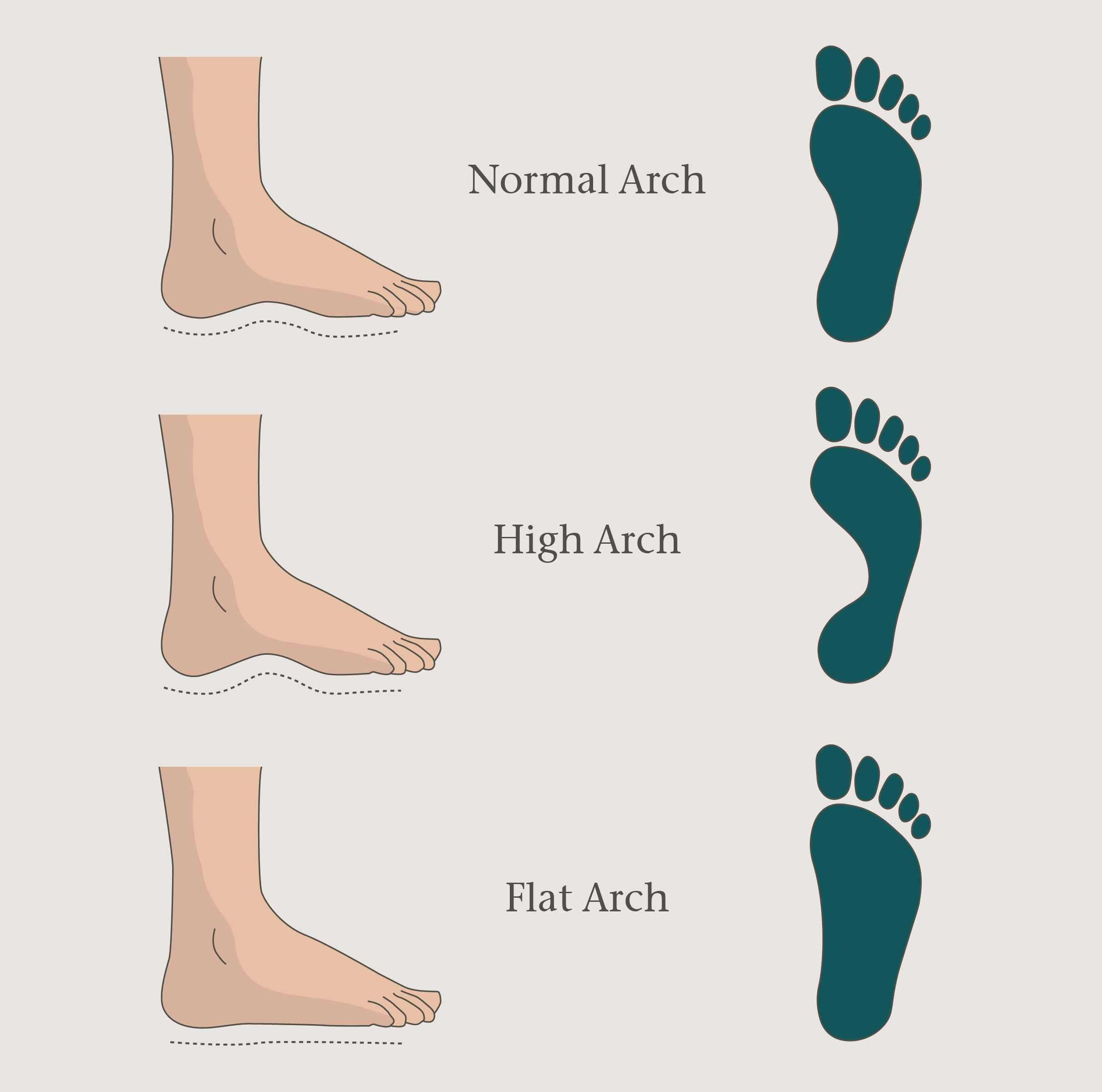
Step 2: Gait Analysis
Gait analysis helps you understand how your foot strikes the ground. You can perform a basic analysis at home. You'll need a smartphone or camera to record and a treadmill or a flat surface for walking/running. Set up your camera to record your feet as you walk or run. Walk or run in a straight line for a few minutes while recording. Watch the video in slow motion to observe how your feet land and push off.
Analyzing Your Gait:
- Overpronation: If your foot rolls inward excessively, you are an overpronator, often with flat feet. The Best Socks are arch-support socks.
- Underpronation (Supination): If your foot rolls outward excessively, you are an underpronator, typically with high arches.
- Neutral Pronation: If your foot lands on the outside of the heel and rolls inward slightly to absorb shock, you have neutral pronation.
Step 3: Determining Other Specific Foot Types and Conditions
- Wide Feet: Measure the width of your foot at its widest point (usually across the ball of the foot). If this measurement is significantly wider than the average shoe size, you have wide feet.
- Narrow Feet: Measure the width of your foot at the widest point. You have narrow feet if this measurement is significantly narrower than average for your shoe size.
- Long Toes: If your toes are longer than average, especially if the second toe is longer than the big toe (Greek toe), you have long toes.
- Bunions: If you have a bump at the base of your big toe that causes the toe to angle towards the other toes, you have bunions.
- Frequently Swollen Feet: If your feet tend to swell regularly, either due to medical conditions, long periods of standing, or other factors, you often have swollen feet.
Step 4: Toe Types
While the type is not a significant factor in choosing socks, it can still provide insight into your foot shape. If your toes frequently come into contact with your shoes, choosing socks that can provide a comfortable barrier to reduce friction and irritation is important. Socks made from natural materials are often better at managing moisture and reducing the risk of blisters, especially if you have any of the above toe types. Proper shoe fit is also crucial to ensure that your toes are not cramped or pressured, leading to further discomfort and foot issues. Here are the types of the shapes:
- Egyptian: Big toe longest; tapered.
- Roman: First three toes equal length.
- Greek: Second toe longest.
- German: All toes are similar in length.
- Celtic: Big and fourth toes are the same length.
- Orient: Mixed tapered and straight toes.
- African: Broad forefoot, shorter toes.
- Aboriginal: Similar to German but broader.
- Norwegian: Tapering toes, rounded shape.
- Mongolian: First three toes similar length, broad foot.
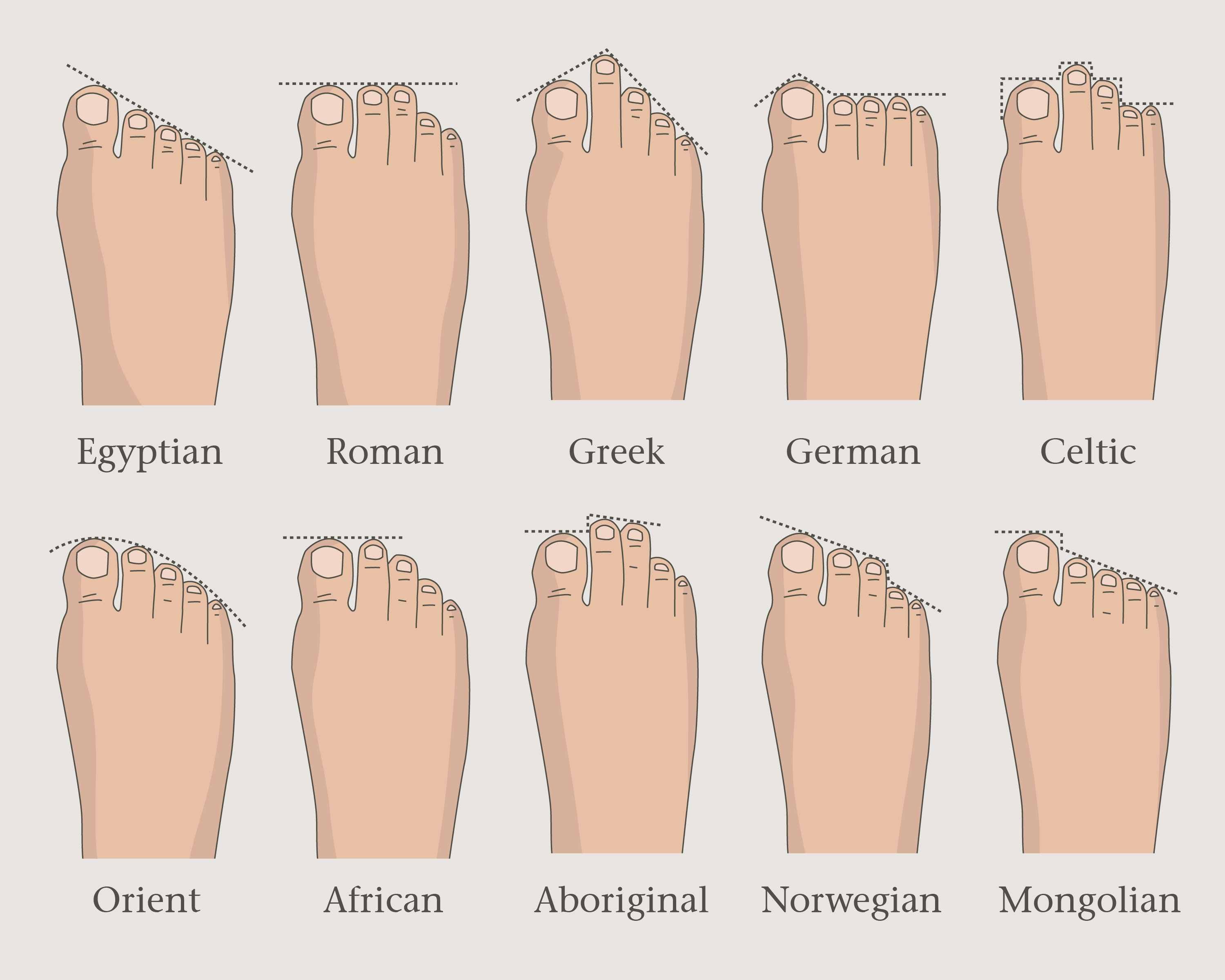
What's The Best Sock for Your Feet Shape?
Choosing the right socks based on your foot shape can significantly enhance comfort and support. Here are the best options for various foot shapes:
- Flat Feet (Fallen Arches): Arch-support socks to provide stability and reduce strain.
- High Arches: Cushioned socks to offer extra support and comfort.
- Wide Feet: Socks with a wider fit to ensure comfort and prevent constriction.
- Narrow Feet: Snug-fitting socks to avoid bunching and provide a better fit.
- Long Toes: Socks with a seamless toe design to reduce irritation.
- Bunions: Soft, stretchy socks that minimize pressure on the bunion area.
- Frequently Swollen Feet: Compression socks to improve circulation and reduce swelling.
Types of Socks: Men, Women, and Kids
Socks come in various styles and designs to suit different needs and preferences across ages and genders. Here are the main types:
- Socks for Women: Whether stylish patterns for a trendy look or soft, breathable materials for all-day comfort, the types of socks for women are versatile and diverse, meeting the needs of various preferences and lifestyles.
- Socks for Men: There are various types of socks for men, including athletic socks for sports and everyday socks for comfort and practicality. Each type is designed to provide the right support and style for different activities and environments, ensuring that men can find the perfect pair for any occasion.
- Unisex Socks: Designs that work for both men and women, offering comfort and a good fit for everyone. Unisex socks are perfect if you want a simple, practical option that suits all tastes.
- Kids' Socks: Kids' socks come in playful designs and smaller sizes, offering extra comfort and durability for active children.
Explore Q for Quinn’s sock collections for kids of all ages, from babies to toddlers. Discover playful patterns and classic designs that ensure softness and durability for every little foot.
Socks Care and Maintenance
Proper care and maintenance can extend the lifespan of your socks and ensure they remain comfortable and effective. Here are some tips:
- Washing Socks: To prevent damage to the fibers, wash socks in cold or warm water and avoid using bleach. Learn how to wash different types of socks properly to maintain their quality and softness. Check out our blogs on how to wash wool socks and how to wash Merino wool socks for detailed guides.
- Organizing Your Sock Collection: To make it easier to find matching pairs, organize your socks by type and color. Follow these tips to organize socks efficiently, save time, and tidy your drawer.
- Determining the Right Number of Socks: Assess your lifestyle and activities to determine how many socks you should own and how many pairs of each type you need.
- Frequency of Changing Your Socks: Change your socks daily to maintain foot hygiene and extend the life of your socks.
Final Thoughts
Choosing the best types of socks for your foot type and activities can enhance comfort and health. Proper care and maintenance will keep your socks in excellent condition, providing ongoing support and style. Whether you need socks for everyday wear, specific activities, or different age groups and genders, investing in quality pairs tailored to your needs is always a smart choice.




